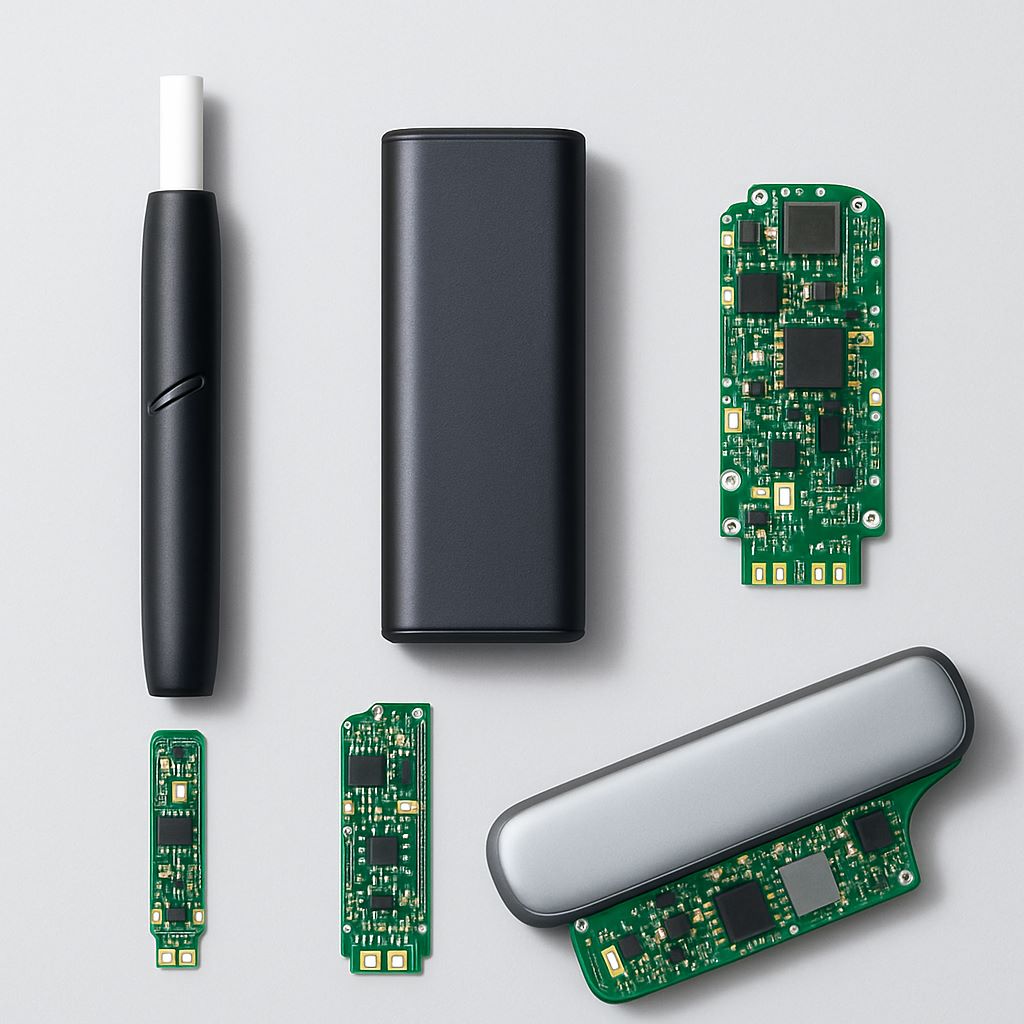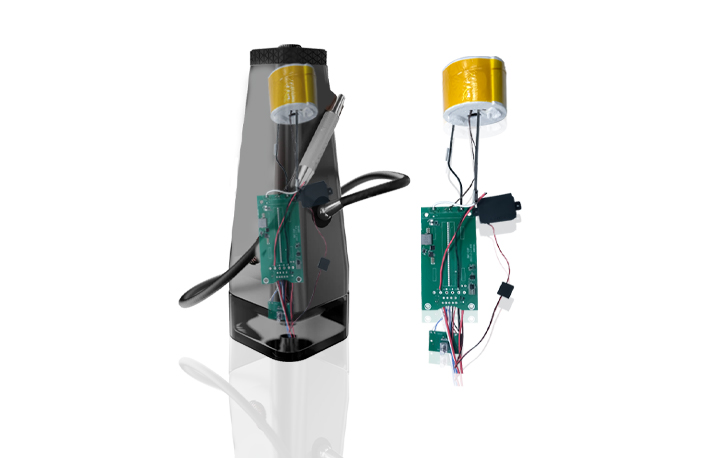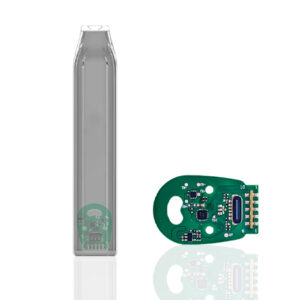The global heated tobacco device market has evolved into a highly diversified field, where form factor significantly influences PCBA design. While the principle of heating tobacco to release aerosol without combustion remains consistent, the technical challenges vary greatly between stick-style, box-style, and integrated devices. Each form factor imposes unique constraints on component placement, thermal management, power regulation, and signal integrity, requiring a tailored engineering approach.
For manufacturers seeking market success, the ability to customize heated tobacco device PCBA for each form factor is no longer an advantage — it’s a necessity. In this article, we explore the essential considerations for circuit layout optimization in these three device categories, combining performance stability, safety compliance, and manufacturing efficiency into one coherent design philosophy.
1. Stick-Style Heated Tobacco Devices: Ultra-Compact, Thermal-Sensitive Layouts
Stick-style heated tobacco devices are slim, portable, and discreet, appealing to users who prioritize convenience. Namun, the design constraints are extreme — the internal diameter often falls below 15mm, forcing PCB engineers to make aggressive trade-offs in component placement and heat dissipation.
In the stick-type heated tobacco device PCBA design, engineers must carefully address:
-
Board Shape and Size Adaptation
The PCB often requires a narrow, elongated layout, sometimes employing flexible PCBs to fit irregular geometries. A rigid-flex hybrid can integrate the heating control module on a rigid section, while sensors and battery interface reside on a flexible tail. -
Thermal Control in Confined Spaces
With a heating chamber placed only millimeters away from the control electronics, thermal isolation is critical. Using heat shields, thermal vias, and high-Tg substrates ensures that operational temperatures stay within safe limits, preventing MCU performance drift. -
Signal Integrity for Temperature Sensors
Since temperature feedback loops are short yet exposed to high EMI from the heater, designers must use shielded traces or differential routing to preserve sensor accuracy. -
Battery and Power Delivery
Stick devices typically use smaller Li-ion cells (e.g., 350–650mAh). To ensure consistent output, high-efficiency buck-boost converters are essential, especially when battery voltage drops near cut-off.
In summary, the stick-style heated tobacco device PCBA design revolves around maximizing thermal safety, ensuring power stability, and maintaining precise temperature control, all within a slim mechanical profile.
2. Box-Style Heated Tobacco Devices: High Power, Modular Design Freedom
Box-style devices offer ample internal space, allowing for larger batteries, more robust heating modules, and advanced user interfaces. This freedom enables engineers to prioritize modularity and maintainability in PCBA design.
Key aspects of box-style heated tobacco device PCBA customization include:
-
Multi-Layer PCB for High Current Paths
Box mods often drive higher power heating elements, requiring wide copper traces and multi-layer boards to handle currents without excessive resistance or voltage drop. -
Segregated Functional Modules
Engineers can physically separate power electronics, control logic, and user interface circuits onto different boards or subassemblies. This reduces EMI coupling and allows for independent upgrades. -
Advanced Power Management
With larger batteries (1200mAh+), synchronous buck converters, and high-side current sensing can improve efficiency and safety. Dual MOSFET arrangements ensure reliable cut-off under fault conditions. -
Enhanced Connectivity and Firmware Features
Some box-style devices incorporate Bluetooth or USB-C charging with firmware upgrade capabilities. This requires careful EMC filtering to prevent RF interference from affecting heating control loops. -
Thermal Strategy
Larger housings allow for heat sinking and airflow channels, minimizing the temperature rise around sensitive ICs even during extended sessions.
Overall, the box-style heated tobacco device PCBA design allows for greater functional complexity and durability, but demands robust EMI control and advanced thermal management to ensure reliability.
3. Integrated Heated Tobacco Devices: Balancing Aesthetics and Engineering
Integrated devices combine a battery, a heating module, and a storage case into a single unit. This form factor emphasizes a premium user experience, but presents unique challenges in PCBA design due to combined mechanical and electrical constraints.
When designing PCBA for integrated heated tobacco devices, key priorities include:
-
Unified Control Board Design
Unlike modular systems, integrated devices often consolidate control, charging, and heating circuits onto a single PCB. Engineers must optimize routing to prevent cross-talk between high-current heater traces and sensitive MCU signals. -
Mechanical Integration with Enclosure
Since the enclosure often serves as both aesthetic shell and structural frame, PCB mounting must account for shock resistance and prevent microfractures from daily handling. -
Complex Battery Management
Integrated devices may house multiple cells for extended runtime. This requires balanced charging circuits and advanced BMS (Battery Management Systems) to ensure safety. -
Compact Multi-Function Connectors
To maintain sleek lines, integrated devices often employ custom pogo pin interfaces or magnetic charging contacts, necessitating precise PCB pad alignment and reinforcement. -
User Feedback and Interaction
Premium integrated devices may feature LED indicators, haptic feedback, and touch controls, all of which require careful EMI suppression to avoid false triggers during heater activation.
In short, the integrated heated tobacco device PCBA design is a tightrope between luxury aesthetics and robust engineering, where every circuit decision must align with industrial design goals.
Cross-Form Factor Engineering Principles
While stick, box, and integrated devices differ greatly, several universal PCBA design principles apply across all heated tobacco products:
-
Thermal Isolation is Non-Negotiable — No matter the size, keep heat away from control electronics.
-
Signal Integrity is Critical — Accurate temperature control depends on clean sensor feedback.
-
Battery Safety Comes First — Every design should incorporate redundant cut-off and overcurrent protection.
-
Manufacturability Matters — Designs must fit existing assembly lines and pass IPC standards.
-
Compliance with Regulatory Requirements — Materials, EMC emissions, and battery safety must meet international certifications.
Kesimpulan
Optimizing the heated tobacco device PCBA requires a deep understanding of each form factor’s unique constraints. Stick-style designs demand miniaturization and thermal safety above all. Box-style devices thrive on modularity and power management. Integrated devices call for harmonizing engineering precision with industrial design elegance.
Rimyi’s engineering solutions leverage custom PCB design, substrate selection, and thermal simulation to ensure that our clients’ products not only meet technical requirements but also deliver exceptional user experiences in competitive markets.
By combining component-level expertise with system-level thinking, we ensure every heated tobacco device PCBA is optimized for performance, compliance, and market appeal. In an industry where form defines function, customized PCBA design is the foundation of lasting success.



